- Home
- Sustainability
- Environment
- Responding to Nature-Related Issues
- Biodiversity Conservation in Company-Owned Forests in Japan and Planted Forests Overseas
Biodiversity Conservation in Company-Owned Forests in Japan and Planted Forests Overseas
Biodiversity Conservation in Company-Owned Forests in Japan
Our Policy on Biodiversity Conservation applies to the company-owned forests in Japan. We conserve "diversity of ecosystems" through proper management of conservation areas and consideration of forest continuity, "diversity of species" through protection of rare plants and animals, and "genetic diversity" through maintenance of wildlife populations. In keeping with these policies, forests are subject to appropriate zoning and management according to certain criteria, such as the increment of trees. We also strive to prepare an endangered species list and a waterside forest management manual, and check for rare species when clear-cutting and opening work roads.
Policy on Biodiversity Conservation in Company-Owned Forests in Japan
(Excerpt) (June 2006)
- Diversity of ecosystems
We will properly manage strictly protected areas designated under the Natural Parks Law of the Japanese government and other legislation in a manner stipulated by the law. In other areas, we will ensure continuity of forests by limiting the area of forest harvested, particularly when clear cutting is conducted. - Diversity of species
We will work to prevent a decline in the number of species existing in natural forests by refraining from expansive planting projects and other extreme activities involving the replacement of species that would have a major impact on existing ecosystems. We will also give the utmost consideration to the protection of rare flora and fauna in all operations, making reference to the Sumitomo Forestry Red Data Book. - Genetic diversity
Genetic variation and the maintenance of populations to support them are challenging. However, analysis is complicated and therefore we will closely watch monitoring activities carried out by government and public institutions and their findings.
Creation of the Sumitomo Forestry Red Data Book
Sumitomo Forestry creates a Sumitomo Forestry Red Data Book listing flora and fauna at threat of extinction which may exist in company-owned forests and distributes it to employees and contractors involved in forest management. By carrying the book with them during operations, personnel can refer to the opinions of specialists when they come across flora and fauna included in the book and manage them appropriately. While using the latest version of this book, we will continually advance measures focused on biodiversity and update the content of the text as necessary.
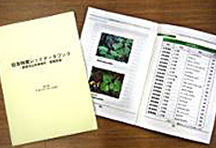
Sumitomo Forestry Red Data Book
Creation of the Riparian Forest Management Manual
With the aim of protecting waterside areas that are home to diverse species, the company has also used the Riparian Forest Management Manual to ensure the appropriate management and preservation of areas around bodies of water. Areas designated for protection under the "Riparian Forest Management Manual" are referred to as riparian forest management zones, where restrictions are placed on activities such as logging and the construction of forest roads and work paths. Riparian forest management zones are registered in a database, and we ensure water-conscious operations by checking these zones and assessing the feasibility of planned activities before implementation.
Wildlife Monitoring Surveys
Sumitomo Forestry monitored wildlife inhabiting company-owned forests. Surveys were conducted in four areas-Mombetsu (Hokkaido), Niihama (Shikoku), Hyuga (Kyushu) and Kinki region (Honshu). The results were used to create basic reference materials relating to biodiversity and to ascertain the impact of forestry on the surrounding environment over the long-term.
Nine surveys were conducted from 2008 to 2016. The results of the surveys showed that the number of population and species of mammals and birds change during the gradual transition of small clear-cut areas to forest, indicating that biodiversity is maintained by forestry.
While a number of species decline temporarily, small size of clear-cut areas has been shown to distribute places suitable for umbrella species* such as hawks and land appropriate for hunting in a mosaic shape in addition to realizing a favorable environment for life such as the species above to thrive.
We will continue to work on operations that can appropriately maintain the environmental conservation and biodiversity conservation functions in company-owned forests, based on the monitoring results.
*Consumers at the top of the food chain, the ecological pyramid structure in the area
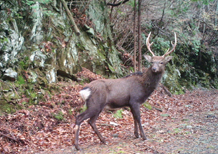
Japanese deer confirmed in Niihama (Shikoku) forests in fiscal 2016
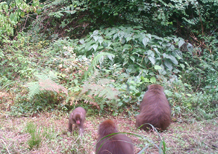
Japanese monkeys confirmed in Niihama (Shikoku) forests in fiscal 2016
Appropriate Control of the Deer Population
Due to recent increase in wild deer throughout Japan, there are concerns about increased damage to forestry, such as damage to young leaves and bark, and loss of biodiversity and soil runoff due to loss of vegetation caused by damage to herbaceous plants on the forest floor. By capturing and exterminating deer and installing tree shelters and protective nets to protect garden vegetation, the Sumitomo Forestry Group is contributing to prevention of feeding damage caused by deer, growth of healthy forests, conservation of biodiversity by maintaining a variety of forest floor vegetation, and prevention of local disasters by preventing soil runoff. Tree shelters are effective against damage of animals other than deer, and contribute to comprehensive forest management for next generation through sustainable growth of forests. In fiscal 2024, we sold and installed approximately 50,000 tree shelters inside and outside the company, which are used in forests throughout Japan.
Certification as a Nature Symbiosis Site
Under the Ministry of the Environment's certification program for "Nature Symbiosis Sites," which was launched in fiscal 2023, two locations were certified: one in 2023, a portion of company-owned forest in Niihama City, Ehime Prefecture; and another in 2024, the "Manabi no Mori" at Mt. Fuji, part of which is managed by the company under a lease agreement with the national forest. "Natural symbiosis site" is an initiative promoted by the Ministry of the Environment to achieve the "30by30" target for "Nature Positive". It certifies areas where biodiversity is conserved by private companies, such as Satochi-satoyama and corporate forests.

30by30 Alliance logo
Company-Owned Forest in Niihama City, Ehime Prefecture
There is a community of rare alpine plants "Tsugazakura (Phyllodoce nipponica) in this certified area. It is considered to be a species started in the ice age, and is highly valuable in terms of plant geography, ecology, and genetics because it is a native specie growing naturally in southern limit. In 2019, the "Tsugazakura (Phyllodoce nipponica) of Mt. Douzan" was designated as a natural monument.
In 1996, Sumitomo Forestry formed Tsugazakura (Phyllodoce nipponica) Nature Conservation Council with Niihama City and other local entities, and has since been engaged in conservation activities with local mountaineering organizations. In addition, Tsugazakura (Phyllodoce nipponica) of Mt. Douzan Preservation and Utilization Plan Committee, which includes experts, formulated a 10-year conservation plan starting in fiscal 2024. We will continue to engage in conservation activities involving local related parties.
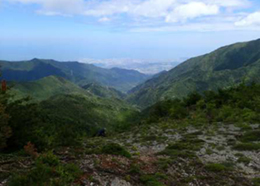
Tsugazakura (Phyllodoce nipponica) of Mt. Douzan (provided by Niihama City, photographed in May 2018)
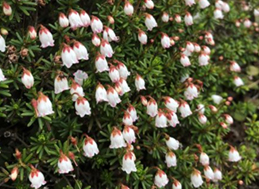
Tsugazakura (Phyllodoce nipponica), an endangered species in the Ehime Red Data Book (provided by Niihama City, photographed in May 2022)
Mt. Fuji Manabi no Mori
The "Manabi no Mori" at Mt. Fuji is located in the national forest at the foot of Mt. Fuji, which suffered significant damage from Typhoon No. 17 in 1996. In order to restore the original richness of the forest, the company named a portion of the national forest "Manabi no Mori." Under a long-term plan with a 100-year perspective, we have been implementing a natural forest restoration project since 1998. In the certification review, high praise was given for the forest’s ongoing regeneration, its role as a habitat for rare flora and fauna, and its provision of diverse activity spaces for people. The involvement of experts in creating activity plans and the establishment of a monitoring system were also highly valued.
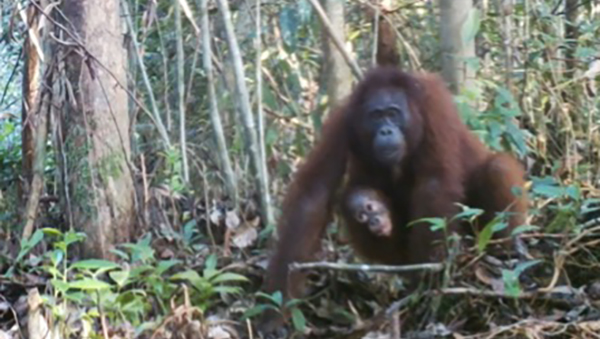
Condition after catastrophic damage (1998)
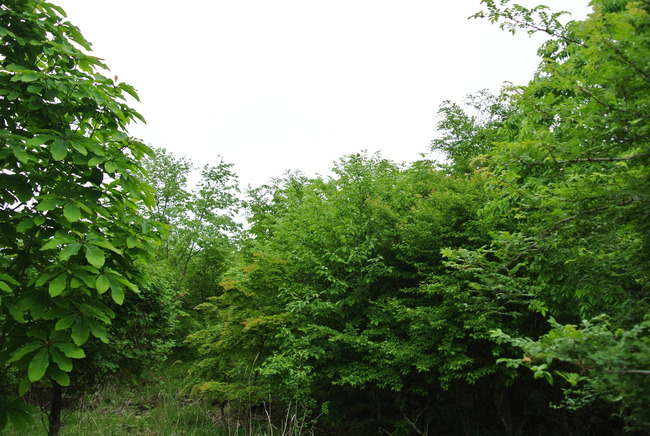
Growth of planted trees (2016)
- Click here for related information
Biodiversity Conservation in Planted Forests Overseas
Initiatives in Indonesia
More than half of living species throughout the world live in rainforests, which are said to be the treasure troves of life. However, rainforests are slowly disappearing today due to a variety of issues from disordered development and illegal logging to forest fires. The Sumitomo Forestry Group subsidiary companies PT. Wana Subur Lestari (WSL), PT. Mayangkara Tanaman Industri (MTI) and Kubu Mulia Forestry (KMF) conduct operations balancing working forests and environmental conservation in the West Kalimantan province of Indonesia.
Before starting afforestation business for this industry, we conduct precise measurements and surveys to determine conservation areas, buffer zones and forestation areas. Conservation areas are subject to regular animal and plant surveys. In addition to population monitoring of orangutans and proboscis monkeys, which are rare animals, studies are conducted on fruit-bearing trees, their source of food.
Observations in the dark for the numerous animals active in the early morning or late at night require proficient skills. Sumitomo Forestry is attempting to directly observe proboscis monkeys and orangutans in the early morning and night by setting up automatic photography using camera traps or drones equipped with heat sensors.
Camera traps installed in conservation areas photographed 15 species and 161 individuals at WSL, and 20 species and 153 individuals at MTI in 2024.
We photographed an adult orangutan with its child for the first time in fiscal 2019 and confirmed a higher population than in surrounding areas in fiscal 2020. These results verify the growing orangutan population.
Peatlands store a tremendous amount of water. Sumitomo Forestry surveys not only ecosystems on land but also in aquatic habitats due to concerns about the impact of our operations on rivers. In the lower basin of an area managed by WSL, we have discovered a habitat of Irrawaddy dolphins, which are designated as an endangered species. Examples of monitoring surveys of aquatic creatures in rainforest peatlands are few and far between. These Sumitomo Forestry surveys are pioneering the work worldwide.
Additionally, at Bina Ovivi Pari Semesta (BIOS), which is engaged in mangrove forest conservation in West Kalimantan, 15 endangered species—comprising five mammals, six birds, and four reptiles—among the diverse animal species inhabiting the area have been designated as priority conservation targets. Through daily patrols, monitoring, and vegetation restoration activities, we are working to conserve and create habitats for these rare species.
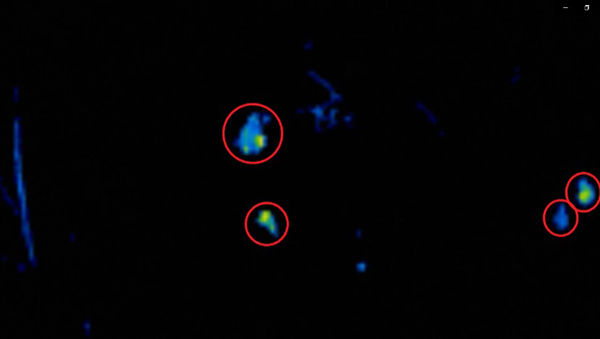
Direct Observation of Animals Using Heat Sensors
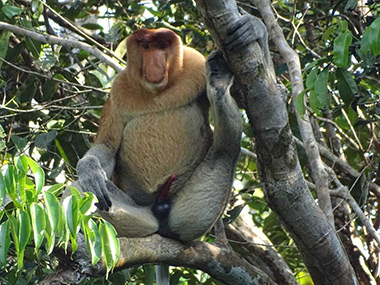
Long-nosed monkey observed by WSL (photographed in 2023)
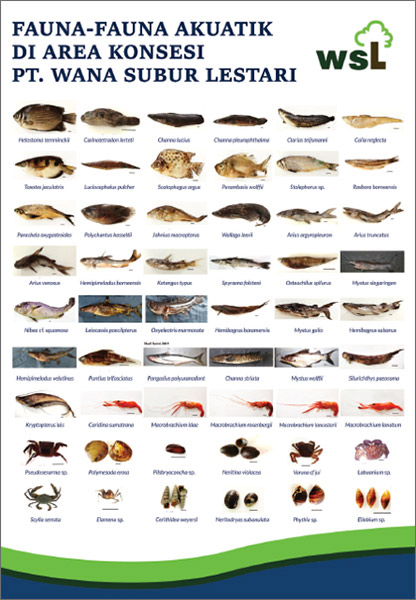
List of Aquatic Creatures Discovered Through the Survey
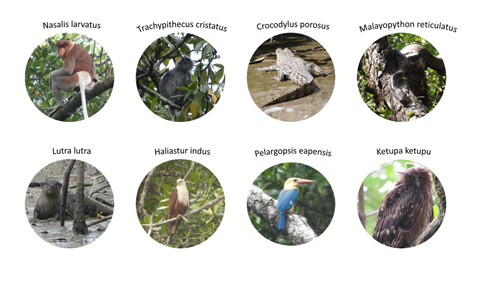
Examples of BIOS Conservation Target Species
Initiatives in New Zealand
Sumitomo Forestry strives to protect Kea (Large Parrot Species), which is a parrot unique to the South Island of New Zealand. Kea is the only parrot in the world to live in mountainous areas, and it is considered one of the smartest birds on the planet. It is a bird that is protected as an endangered species (about 5,000 birds throughout New Zealand), and adored by the people.
It has been confirmed that it nests in a drainpipe in forest of Tasman Pine Forests Ltd. (TPF), a subsidiary of the Sumitomo Forestry Group. In cooperation with the Kea Conservation Trust, we strived to set up traps and fences around the area to protect eggs from natural enemies. As a result, it was confirmed that one chick hatched in 2021, three chicks hatched in 2022, and new nests were created in 2023. In 2024, conservation activities such as camera monitoring continued. We will continue these activities in the future.
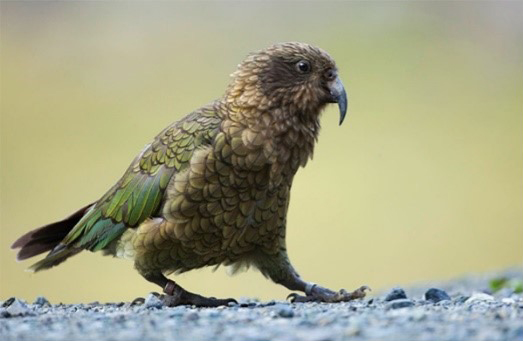
Kea (Large Parrot Species)
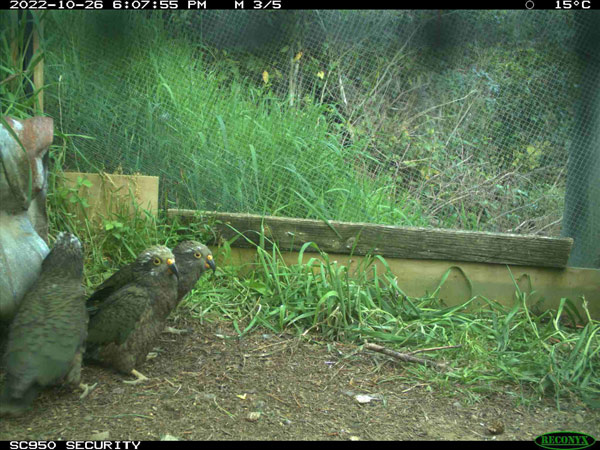
Chicks found in TPF forests
- Click here for related information
- Home
- Sustainability
- Environment
- Responding to Nature-Related Issues
- Biodiversity Conservation in Company-Owned Forests in Japan and Planted Forests Overseas

